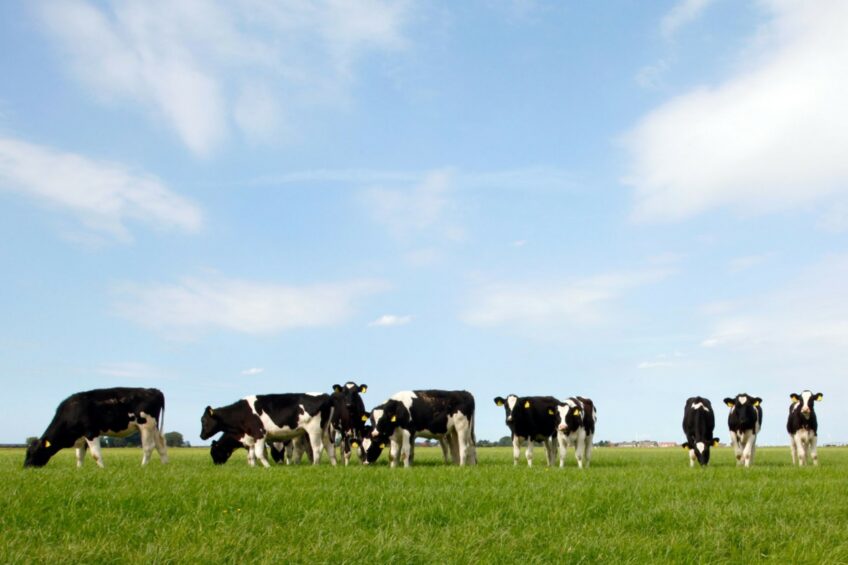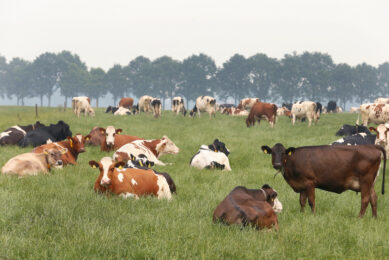How is dairy in the US going greener?

The US has made major progress in its sustainability efforts. In 2017, for the same volume of milk, 30% less water and 21% less land was used along with 19% smaller carbon footprint compared to 2008. But what is behind these achievements? A Rabobank report explores the strategies, approaches and goals in the sector. Here, a summary of the recent report, US dairy’s journey toward meeting sustainability goals.
Achieving more milk per cow with less feed is a strategy that has played a significant role in the road to sustainability, and it is said that it will continue to make headway in the coming decades.
The Rabobank report* states that the US dairy sector’s greenhouse gas (GHG) reduction initiatives are mainly driven by the industry rather than government regulation, California being a key exception.
Lucas Fuess, senior dairy analyst at RaboResearch North America, says: “The dairy sustainability strategy in the US is largely industry-led, centered around the Net Zero Initiative [NZI]. While some states have adopted regulations or incentives around dairy sustainability, the US on a national level differs from some other key global dairy regions in that there is less government regulation driving the future of what sustainability looks like for the industry.”

For US dairy, industry leadership has put 3 main goals in place. Led by the Innovation Center for U.S. Dairy, the goals to be achieved by 2050 under the US NZI are:
- Achieve greenhouse gas (GHG) emissions neutrality
- Optimise water use while maximising recycling
- Improve water quality by optimising the utilisation of manure and nutrients.
The report states that within these NZI goals, feed, enteric methane, manure and energy are key areas of focus in the strategy to tackle emissions from the sector and ensure a sustainable and greener path. Results of the progress made will be shared in 2025, with an update expected every 5 years. The report cites enteric methane reduction, methane digesters, manure management and efficiency gains as the areas that will have a major impact on the US reaching the goals set for 2050.
Enteric methane
As enteric methane represents a substantial part of overall GHG emissions, tackling it is high on the agenda. Feed additives will be key in the reduction strategies in the coming years. However, the amount of emissions reduction depends on different variables, such as effectiveness, adoption strategies on-farm and regulatory approval.
Manure management
The report adds that since the GHG at a dairy farm is largely due to manure output, methane digesters will continue to have a significant role in reducing emissions, as will manure management methods, which can have a promising effect on lowering emissions and are cheaper than digesters. Manure management methods that can be used in addition to a digester include compost packing, flush-to-scrape conversion, solids/liquid separation and wastewater filtration systems.
Rabobank predicts that most dairy farms with more than 1,000 cows will eventually invest in methane digesters, with farm sizes ranging between about 500 and 1,000 cows on a single or multi-farm basis. There are significant costs involved in investing in methane digesters; however, they remain an attractive solution to reduce methane emissions and can provide income through, for example, the sale of electricity or renewable natural gas.
Improving efficiency
Overall efficiency has advanced in leaps and bounds over the years, with major improvements seen. One of the steady trends mentioned in the Rabobank report is the milk-per-cow gains. Milk yield has seen real growth since the 1950s due to genetic improvements. Today, the average is 70lb (32kg) milk/cow/day with top high-achieving Holsteins producing above 100lb (45kg) per day.
It isn’t just about producing more; what has happened so far is that the dairy industry has done so with reduced water needs, less feed, reduced manure output and a shrinking herd size. This gives a clear indication of how far the US sector has come in efficiency gains over the decades. Achievement journeys are driven by various stakeholders. In the dairy sector, many parts are essential in its success – consumers, cooperatives and processors all play a role in the progress of the sector. The Rabobank report further states that most US dairy cooperatives and processors have publicly shared sustainability reports that include revealing specific goals and areas targeted for emission reductions in the coming years.
Leaders in emissions reduction
“With most companies signing on to the industry-driven guidance, little change at the individual company level is expected, at least in the near term. Importantly, from a leadership perspective, some US dairy companies have set more aggressive timelines for achieving sustainability goals, setting themselves apart from their competitors even as a united industry works towards shared goals,” says Feuss.
Furthermore, some of the companies mentioned in the report that have had a real hand in the sustainability trends now seen in the US dairy industry include:
1. Dairy Farmers of America (DFA)
Of DFA’s emissions, 98% are scope 3 and driven by ‘indirect’ farm-level emissions from the cooperative’s farmer-member suppliers. DFA says that 1% of emissions are scope 1 and 1% are scope 2. It has set a science-based target to reduce emissions by 30% across its business by 2030.
2. Land O’Lakes
By 2030, the cooperative aims to reduce its scope 1 and scope 2 emissions by 42% and scope 3 emissions by 25% (from a 2020 baseline). It will implement sustainable packaging by 2030 and reduce landfill waste by 50% by the end of 2030.
It aims to reduce scope 1 and scope 2 emissions by 27% by 2030 (2017 baseline) and scope 3 emissions by 30% by 2030. In one of its processing plants it has invested in “carbon-free energy”, and water-reducing strategies are a priority as well as zero waste making its way to landfills.
4. California Dairies Inc. (CDI)
Aligned with the US Dairy Initiative for carbon neutrality by 2050, by 2030 CDI aims to have 30% lower emissions including scope 3 emissions (2020 baseline). CDI has 66% of its milk produced on farms with a methane reduction project, 55% of its energy that powers processing plants is from renewable or carbon-free sources and 40% of the feed for cows is from agricultural by-products.
Funding and challenges
These company commitments all aid in the path to a sustainable US dairy sector. However, much has been achieved only as a result of grants and funding, and there remain financial barriers. For farmers to adopt some measures, funding is critical in their progress. Additionally, more industry alignment is required. The Rabobank report further adds that the Biden administration does see agriculture as significant in its climate-smart endeavours. President Biden signed the Inflation Reduction Act (IRA) in 2022, which set the country’s path towards meeting its climate commitment to slice GHG emissions in half by 2030 (compared to 2005 levels).
During COP27, secretary of agriculture Tom Vilsack highlighted the USDA’s US$ 2.8 billion investment in 70 pilot projects, key for producers and communities, and in December 2022 an extra US$ 325 million dollars has been granted for 71 projects. This totals US$ 3.1 billion for 141 projects.
Some challenges with funding remain:
- Release of funds has been slow due to the need for more tangible and measurable actions.
- 2024 leadership changes could delay release further.
- Reduction in grant availability or revenue credits available to farmers investing in costly projects would jeopardise the date of emissions reduction progress.
- Some projects and levers to reduce emissions can only progress with funding assistance.
As can be seen, there are many aspects to achieving and maintaining a sustainable dairy sector. Collaboration, legislation and collective efforts are much needed and are just some of the aspects required for the steps in the journey to a sustainable future and to realise the goals that have been set.
Senior dairy analyst Feuss adds: “Collaboration will be critical to achieving the universal and aligned industry goals. Most US dairy cooperatives and processors are aligned with the industry strategy and goals, with collaboration important to achieving future successes.”
In addition, the report states, funding has to continue in the near term for progress to continue.
*For the full Rabobank report, click here.
Join 13,000+ subscribers
Subscribe to our newsletter to stay updated about all the need-to-know content in the dairy sector, two times a week.










